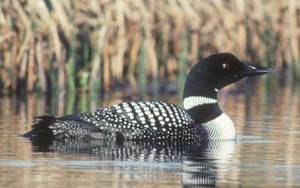 The wailing cry of the Common Loon is a staple sound effect in nature videos. The eerie, echoing call is one of the most distinctive sounds of northern lakes. Loons, however, do not breed in southern Michigan, so the Portage Lake region experiences Common Loons differently from northern lakes. Rather than haunting singers with a checkerboard back, the Chain of Lakes sees brown, quiet, winter-plumaged birds as they migrate through the area in early and late winter. Despite their lack of striking voices and plumage, winter loons are still fascinating.
The wailing cry of the Common Loon is a staple sound effect in nature videos. The eerie, echoing call is one of the most distinctive sounds of northern lakes. Loons, however, do not breed in southern Michigan, so the Portage Lake region experiences Common Loons differently from northern lakes. Rather than haunting singers with a checkerboard back, the Chain of Lakes sees brown, quiet, winter-plumaged birds as they migrate through the area in early and late winter. Despite their lack of striking voices and plumage, winter loons are still fascinating.
Like many deep-water diving ducks, loons’ feet are placed very far back on their body. This allows them to gain maximum thrust from their feet, which propel them forward, so that they can outpace fish and dive up to 200 ft below the surface. In the summer, Common Loons breed on freshwater lakes across the northern US and southern Canada, from Michigan’s Northern Lower Peninsula to the Arctic Circle in Greenland and Alaska. In the winter, they fly south ahead of the freeze-up. Some birds, especially immatures, linger on northern lakes, such as Portage Lake, until they completely freeze over; many adults pass through quickly to coastal wintering grounds on both sides of the Atlantic, on the northern Gulf of Mexico, and on the eastern Pacific Ocean. When the loons return north in the spring, they follow the thaw very closely; loons stage on unfrozen lakes and rivers, leading to dense concentrations at the edge of the open water, and they usually arrive on breeding lakes within days of ice-out.
Loons are quite large and heavy: they are typically 2-3 feet long and weigh 5-15 pounds. In the wintertime, Common Loons are a gray, drab brown above and white below, with a dark hood over the neck and head, contrasting with a pale throat and chest; this is the plumage most frequently seen on the Chain of Lakes. Summer plumage is a striking pattern of black and white, including a checkerboard-patterned back, an all-black head with a deep red eye, and a striped white collar around a black neck. Loons have dark, long, dagger-like bills for catching fish.
Loons breed on forested northern lakes. Because they cannot walk well on land, they build nests along the shore or in floating vegetation, using aquatic plants to create a platform, into which they lay two eggs. The eggs hatch after a month of incubation. The chicks are adorable fluffballs covered in gray down. The fluffy down keeps them warm, but inhibits their diving, so they have difficulty foraging on their own until their sleek, waterproof feathers grow in around seven weeks after hatching. When the chicks tire of swimming, they often ride on a parents’ back while the other parent forages for food to feed the chicks. By twelve weeks, they can fly and hunt on their own, and the parents depart soon after. The juveniles make their way south more leisurely, lingering on their home lake for a few weeks before following the ice south.
Common Loons were so named for their abundance; the term “loon” probably comes from either their awkward, shambling gait on land or their crazy-sounding call. In European countries, they are called Great Northern Divers, for their large size in comparison to other loons, high-latitude occurrence, and prodigy at swimming and diving underwater. The scientific name, Gavia immer, literally translates to “Seabird Great Northern Diver:” Gavia is a general term for a seabird, while immer is the Norweigian name for the Common Loon.
During migration, Portage Lake can be a local hotspot for Common Loons, typically hosting several individuals until freeze-up, depending on the year. They sometimes interact with Bonaparte’s Gulls, which take advantage of the fish pushed to the surface by diving loons. Loons are typically found in the middle of the lake, where the deepest sections remain unfrozen and host larger fish. Loons occasionally mistake shiny roads for open water, and land and become stranded, unable to walk. If you encounter a stranded loon, call a local wildlife rehabilitator to rescue it, such as the Bird Center of Washtenaw County; loons’ sharp, dagger-like bills can cause serious injury, particularly to eyes. If the bird can be returned to open water, it can usually recover and continue on its flight south.
Further Reading
Click Here for information from All About Birds
Click Here for information from Boreal Birds
Click Here for information from Birds of North America
Click Here for information from Conserving Common Loons in Wisconsin
Click Here for a USGS Podcast on Common Loon research